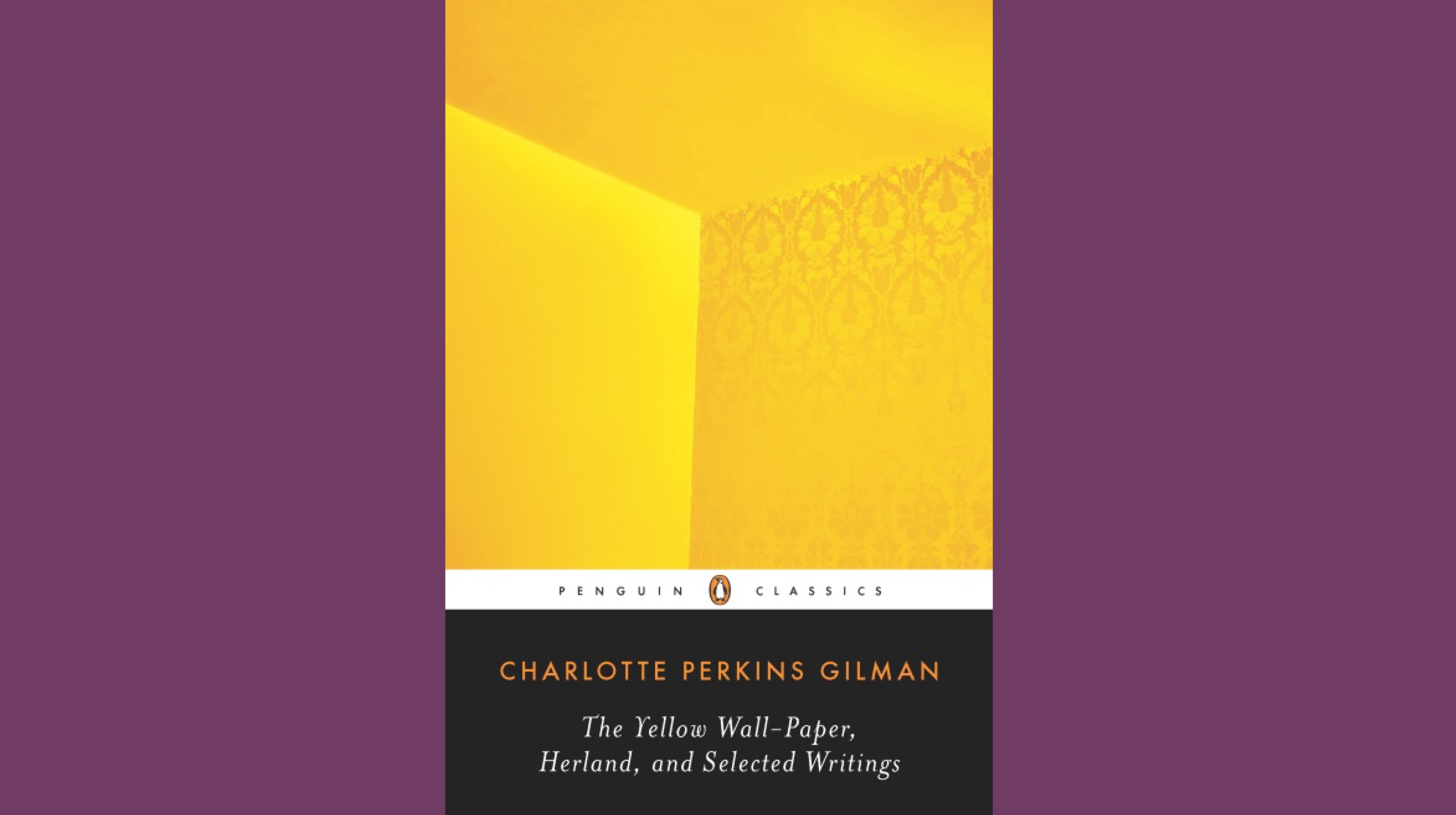Welcome back to Defector Reads A Book! Our May DRAB selection was Charlotte Perkins Gilman's short story The Yellow Wallpaper, which the Defector book sickos have read and discussed. We’ll be down in the comments to chat with you as soon as you’re done reading.
Maitreyi Anantharaman: I will actually begin by (no pun intended) breaking the fourth wall—if you have not read this, you can go and do so now, and then come back to finish reading our discussion. It’s a short story!
Giri Nathan: Great. So I assumed we would start (and maybe also end) by all going around and drawing our renditions of the yellow wallpaper.
MA: In college, I had an art history professor introduce one of our essay assignments by reminding us that visual art isn't meant to be written about because if an artist wanted to say something in words, they would've done that, so, uh, good luck with the paper. Anyway, because of that, I always appreciate great formal art writing, and there’s a lot of it here. I was jotting down every description of that damn wallpaper in my notes.
Kelsey McKinney: “One of those sprawling flamboyant patterns committing every artistic sin.” Absolute banger of an art description, imo.
GN: I loved every single description even though (or because?) each one made me even more confused about what the wallpaper actually looked like. I am forced to assume it is some Lovecraftian horror that words, even extremely artfully and carefully chosen ones, cannot possibly evoke. The pattern was “not arranged on any laws of radiation, or alternation, or repletion, or symmetry, or anything else that I ever heard of.” Damn.
Kalyn Kahler: I read this on my phone at 11:00 p.m. and the descriptions of the wallpaper were so vivid that when I looked away from my phone after the half hour spent reading it I swear I saw the wallpaper on my wall. Then I shut the lights off real quick and tried to sleep.
KM: Giri, that’s kind of what I liked about it, though. Have you ever been in one of those houses with wallpaper in the bathroom? At first you think it’s like a really simple fleur de lis or something and then as you’re looking at it more and more you find more intricacies? I loved that Perkins Gilman created this mesmerizing kind of enchanted wallpaper that as she descends through the depths of her mind reveals itself more and more to her until eventually it is revealing a whole other world.
GN: Yes! While I don’t want to be too glib about the serious themes of this story I have to say that zoning out at a wall and coming up with various fungus and seaweed similes gets a big fat “Same” from me.
KM: What got a big “same” from me is her saying “I think sometimes if I were only well enough to write a little it would relieve the press of ideas and rest me. But I find I get pretty tired when I try.” SAME, BABE.
MA: That’s actually the line that’s stuck with me the most. (Kalyn, I read this in broad daylight and it was still very distressing, so I’m impressed.) It’s tragic when you think about it, that she knows she can find some relief in writing, but also the conditions that would make it possible for her to write aren’t available to her. She finds it “discouraging not to have any advice and companionship about my work.” How terribly sad! And I guess the big theme of this story, too, that the “rest cure” prescribed to women with mental illness actually feeds into this inescapable cycle.
KK: She really gets the difficulties of the blog life: “I don't know why I should write this. I don't want to. I don't feel able.”
GN: I was thinking about how much more unsettling this story is because we get these regular updates on what the narrator feels like writing it. It’s hard to imagine it being remotely as effective written from third-person omniscience.
KK: The saddest part for me is when she said it’s better for her to be in the room with the creepy wallpaper than for her baby to be in the room. “If we had not used it, that blessed child would have! What a fortunate escape! Why, I wouldn't have a child of mine, an impressionable little thing, live in such a room for worlds.”
KM: Giri, I was thinking about that too. Even a tight third person I don’t think would work because the whole point is the psychosis. We’ve seen a lot of novels recently do this kind of thing (I’m thinking specifically of like Heti and Offill), but there’s something terrifying in her certainty, in the fact that she doesn’t think that she’s losing her mind while it is clear to you, as a reader, that she is in such a bad space. This kind of nervous breakdown isn’t one you realize you’re having until it’s over, which I think is what really struck me on this most recent read: the ability of Perkins Gilman to make it clear enough that you understand why she thinks this is true, while realizing it may all be a lie.
MA: Any Wide Sargasso Sea fans here? Jean Rhys hive, rise up?
KM: Wide Sargasso Sea has been in my to-read stack for, I don’t know, seven years. I’m gonna move it to the top. How does it relate here? Fill me in!
MA: Read it! It will fuck you up! Basically, it’s also told by a woman living in these Victorian constraints—society’s and marriage’s—and we’re in her head as she experiences a physical containment that represents those constraints and also drives the woman mad.
GN: So let’s try and describe where our narrator is at. She’s doing something people used to do more of back in the day: convalescing in the countryside, taking in the salutary air, things of that nature. You don’t see that as much anymore. And her husband John has her stuck in this house that they’re renting for three months. And she is in one room of that house.
KM: Often, I have wished that a psychiatrist would prescribe me a stay in the countryside or perhaps a many-months trip to the “sea” for my clinical depression, but let me tell you, I am rethinking that! The house is a colonial mansion with lots of land and a “delicious garden” so that part doesn’t sound so bad.
MA: And at the very beginning of the story, she’s kind of tickled by the whole experience. She thinks it romantic to be in this weird house: “I will proudly declare that there is something queer about it.”
KK: Did this rest cure “treatment” ever actually work? I’m still just so sad she wasn’t even seeing her baby who was IN THE HOUSE. Seems like that would be good for the brain health.
GN: That is a great question. Someone should write a definitive history catching up with all the people who went to the seashore.
KM: One very fun thing I learned about this while googling “yellow wallpaper” and “depression cure rest?” is that the man who prescribed this “rest cure” was also known for prescribing young nervous men to simply go to the west and eat a lot of meat and ride a horse. Unsurprisingly perhaps, the “rest cure” given to women did not work very well but the “West cure” of sun and fun did work! Here’s the article I read.
GN: Remember our pal Septimus? Same prescription! “The best thing for Septimus: ‘It was merely a question of rest, said Sir William; of rest, rest, rest; a long rest in bed.’” Also a similar situation in the sense that his pain is not being taken seriously by his doctor.
MA: Oh, Septimus. Now my heart is broken for the day. Perkins Gilman is very much envisioning this as an argument against the rest cure. She did all the literary analysis work for us by straight up writing a short article called “Why I Wrote The Yellow Wallpaper?” (why can’t all authors have done that?) and the answer is that she’d been prescribed the rest cure, made a “narrow escape” from it and wrote the story “to save people from being driven crazy.”
KM: There’s a line in that article that really upset me because I am constantly having an argument with myself about whether or not writers only write the way their brains work or whether there is a rigorous form of editing that can change the way you write. In that tiny article she says she “came so near the border line of utter mental ruin that I could see over.” Which is a great argument for most of the incredible phrasing of The Yellow Wallpaper being just the way her brain worked. Infuriating.
MA: It’s a great window into an old and still unresolved issue of the way women are understood—or misunderstood, really—by the medical establishment.
KK: Like this line! Where John the doctor husband is never around to keep her company or even try to understand because other people’s problems are more important! “John is away all day, and even some nights when his cases are serious. I am glad my case is not serious!”
GN: Yeah, John becomes this symbol of misguided scientism. Where you are outsourcing all your judgments to institutional knowledge without really thinking too hard about whose input gets to shape that knowledge.
MA: Right. And if we continue the Mrs. Dalloway and Septimus comparison, John is the Dr. Holmes or Sir William Bradshaw of this story, but he’s a much more sinister presence here because he’s also married to our narrator. The husband-wife and doctor-patient relationships sort of bleed into each other, and the result is something pretty toxic, even if she can’t recognize that.
GN: There’s something very darkly satisfying about the ending, with John the expert just fainting in a pile, in front of a problem he did not really acknowledge as a problem at all.
KM: There’s also something so satisfying to me about a doctor who sees guts and gross body stuff all day, just fainting into a big pile of the floor in front of mental illness. Good luck, honey!
MA: Mmm, that’s a great irony I didn’t pick up on.
KK: Earlier in the story she says, “I suppose John never was nervous in his life.” LOL
GN: And without pushing the SPORTS angle too hard it’s obvious that we still don’t have the vocabulary for talking about athlete mental health vs. gruesome physical updates.
MA: Oh? Has athlete mental health been in the news or something?
GN: No, I was just thinking about Joel Embiid’s meniscus and how it would be harder to discuss if he was depressed.
KM: lol
GN: But Kalyn, that’s another great line. Before mental health could be understood as something that literally every human should be concerned with, it’s just something for some specially designated group of Anxiety Patients to think about. John cannot imagine himself as part of this picture. And what do we make of Jennie?
MA: It was tricky to figure out what exactly Jennie’s deal was, because we’re seeing her through the narrator’s eyes, and our narrator is growing more and more suspicious. But Jennie does seem somewhat concerned for the narrator’s well-being in a way that her more flippant brother isn’t. It’s the same paradox as the writing thing: Jennie might be able to help the narrator out, but she also serves as this stand-in for the Normal Woman who can run a household, and so her mere presence actually makes the narrator feel worse.
KM: I haven’t thought much about this, but it is interesting to read “Jennie” as a “capable” version of our narrator who disguises the truth of our narrator’s mental illness by maintaining the house and taking care of the kids. Jennie saves face for the family, which is clearly more important to her husband than our narrator’s actual well-being. She does say early on in the story that the house has many people in it: gardeners and whatnot.
MA: Sort of on the subject of Jennie, I had a moment while reading this where I did a double take, kind of like the one I did while reading about Nick Carraway’s possible elevator tryst with the photographer. I thought maybe I’d missed something. When John enters the room at the very end of the story, the narrator cries “I’ve got out at last in spite of you and Jane? And I’ve pulled off most of the paper, so you can’t put me back!” Who is Jane? There’s no one with that name mentioned before. I did a tiny bit of research into this, and a couple of explanations popped up: one was that it’s a typo, and was meant to read Jennie. But there were other more interesting theories (sorry, all typo-based literary theories are lame), like that it was the narrator’s own name and she had essentially dissociated from herself, or that she had given a name to the woman in the wallpaper, which might make sense, as that woman has slowly come into focus.
KM: I have read this story three times in the last six months and have never, not once, noticed this.
KK: I also did not notice this. Probably because I felt like I was speed reading it because of the frantic pace.
GN: I like this theory! I can’t decide whether Jane is the self she has left behind or the name of the creeping wallpaper woman she has come to replace.
KM: The idea of the disassociated self is really upsetting to me. Maybe this is because of my own mental illness, but it seems highly possible to me that Jane is the narrator's name and Jennie is the name she has given to the disassociated version of herself that is able to perform the tasks she needs to do. This would also explain why at some point her dumb husband is like “This seems good for you! It is working!” while she is literally losing her mind. Separation of Church and State but for your mental illness.
MA: Ooh! Charlotte Perkins Gilman should write an article called “Why I Wrote Jane?”
KM: Something I did not realize until this read is that the “creeping” is probably happening on all fours. She says earlier that the divot on the wall runs just above the “mopboard.” I googled and this means baseboard. And then at the end she says that her “shoulder just fits in that long smooch along the wall.”
GN: The word “creep” was very evocative—she also stares at the moonlight on the wallpaper “till I felt creepy” which I liked a lot—though I hadn’t thought to visualize it, you are definitely right. That matches up with the drawing at the end as well. Maybe “creeping” meant that then. Certainly “smooches” meant something different.
MA: I used my usual sicko audiobook readalong strategy, and the British lady who read this really brought “smooch” alive. Listening to this was kind of strange, because the story was read very sweetly and cheerfully, which actually helps drive home the horror.
KK: As a person who overly uses exclamation points to the point where I censor them out of my emails and texts and slacks, I really really loved the use of exclamation points after so many of her sentences!!!!!! It was so relatable and really gave her a voice that you could hear as you read along. And the italics on words for emphasis was also amazing for that.
GN: I also really appreciated the exclamation points, including how they were spaced on the page ! Like that. Agreed on bringing alive a bright and almost inquisitive voice. I felt like I was receiving a sequence of live texts from the narrator.
KM: “Why there’s John at the door !” That space between the realization he’s home and the exclamation point fills me with terror!
GN: Why there’s Tom editing the post !
KM: NO !
DRAB will be in the comments for the next couple of days to hear your thoughts and chat with you. If you missed out on this month’s book, don’t worry! June is a new month and we’ll announce our next pick soon.






